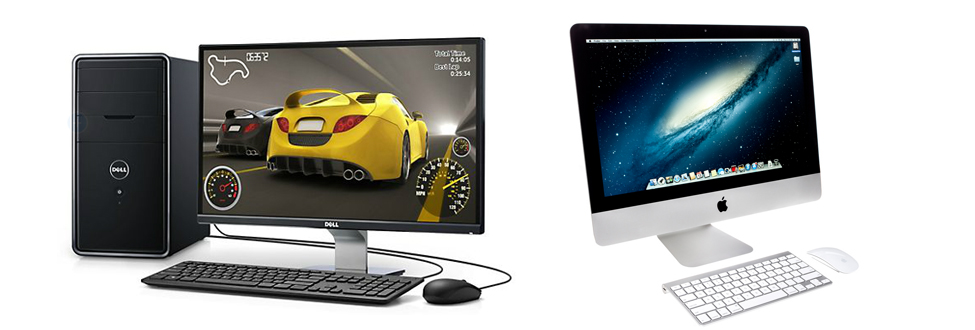The age-old battle of pitting the virtues and vices of Apple OS X computers against Microsoft Windows computers has been the source of computer geek angst ever since the home personal computer first came into being.
Arguing that one is better than the other results in lost friendships, vicious battles and, perhaps, worse fates best left to the imagination. In fact, to some, taking sides can result in utter doom.
Let’s do this, anyway. 😉
The Quiz
Whenever a client asks me whether they should buy a Mac or a PC, I like to ask them four specific questions:
- Is keeping cost down a major factor in how you choose your new computer? (If you answered yes, buy a PC. If you answered no, continue to #2)
- Do you play graphic-intensive, state-of-the-art video games? (If you answered yes, buy a PC. If you answered no, continue to #3)
- Do you care if your computer looks finely designed and has a solid feel? (If you answered yes, continue to #4. If you answered no, buy a PC)
- Do you have a preference for OS X versus Windows? (If you answered yes, buy your preference. If you answered no, then read on)
Let’s delve into more detail on each question.
Question #1: Is cost a factor?
Apples are more expensive. There’s no disputing this argument. They simple cost more. Let’s take a look at a baseline comparison between entry-level desktop machines.
Desktop Example – Entry-Level:
Apple 21.5-inch iMac
Cost: $1,299.00 |
Dell Inspiron Desktop 3000
Cost: $679.98 |
Both of the systems in this example have similar loadouts (in fact, the Dell has a slightly faster processor), however the Apple costs nearly twice as much. Now, let’s move on to ultra-light notebook computers (called Ultrabooks):
Ultrabook Example – Entry-Level:
Apple 11-inch MacBook Air
Cost: $999.00 |
Lenovo U430p Ultrabook
Cost: $649.00 |
When you’re talking about Ultrabooks, there are few Windows-based computers that compare with Apple’s unbelievably thin and lightweight MacBook Air. Even taking that into consideration, the $350 price difference between the two machines (the Apple is 54% more than the Windows PC) is pretty substantial.
Notebook Example – Slightly more than Entry-Level:
Apple 13-inch MacBook Pro
Cost: $1,399.00 |
HP ENVY TouchSmart 15t-j100
Cost: $719.99 |
In order to get the MacBook Pro and TouchSmart equal in terms of loadouts, we had to bump the Mac up to 8GB of RAM from 4GB (+$100) and from a 500GB hard drive to 1TB (+$100). The ENVY needed an additional 2GB of RAM (+$40) and an additional 250GB of hard drive space (+$30). Once again, the price difference between the Mac and PC is nearly double.
Question #2: Do you play graphics-intensive games?
Apple’s computers have been able to run Microsoft Windows (sacrilege!) since Apple switched to Intel processors from Motorola back in the mid-00s. Without the compatibility issue stemming from few developers creating games for OS X, Apple users can now run Windows applications and games.
However, when you’re talking about PC gaming, you will get far better bang for your buck if you buy a desktop instead of a notebook or ultrabook due to the faster graphics cards available to desktop machines.
Unfortunately, to attain the ultra-thin designs of their iMac desktop lineup, Apple uses laptop graphics cards which cannot push the same framerates as their desktop counterparts. Even if you wanted to spend the additional money, you wouldn’t be able to get a truly state-of-the-art video card capable of competing with Windows desktop cards without moving up to Apple’s uber-expensive Mac Pro lineup which starts at an astronomical (to me, at least) base price of $2,999.00.
Question #3: Do you want a computer that feels solidly-designed?
Granted, Windows PC manufacturers like HP have tried to create desktops and laptops (see HP’s ENVY lineup) which use metal and glass to try to reach the same level of elegance of an Apple, but it’s hard to argue against Apple’s design and style which they’ve honed to a fine art.
An Apple iMac wouldn’t look out of place in a billionaire’s Manhattan penthouse whereas a Dell Inspiron 3000 (the Windows desktop in our headline picture above) is just another black box in a long lineage of different-colored boring boxes representing the evolution of the Windows desktop computer.
Question #4: Do you have a preference between Windows or OS X?
Microsoft’s Windows and Apple’s OS X share a lot in common:
- Both are graphic user interfaces.
- Both use mice or touch to navigate.
- Both have rows of shortcuts.
- Both allow for customization.
- … many, many other similarities.
For most people, their preference between Windows or OS X likely stems from whichever operating system they learned first. After that, other factors like whether using a keyboard more than a mouse or vice versa will sway people into one camp or the other.
Personally, I prefer Windows. There are a lot of reasons for this, but one of the main ones is simply that I have a lot more experience with it in a work environment (which is truly where I use my computers most of the time now thanks to tablet for lazy computing use).
Overall
If design isn’t important to you and you don’t have a preference for operating systems, then the choice is pretty obvious since you can get a lot more computing power for your money from Windows PC manufacturers. However, if you want a computer with a heaping helping of design or if you prefer OS X, then you’ll want to take a close look at Apple’s offerings.
Yes, that’s right, I completely dodged the issue – to me, there’s no right or wrong in choosing between Apple OS X and Microsoft Windows, it’s simply a matter of preference and budget.
My History
1980 – My first computer was an Apple IIe with two floppy disk drives when I was three years old.
1984 – My Dad brought home one of the first Apple Macintoshes (they weren’t called “Classic” back then, they were just Macintosh).
1992 – I became frustrated with the lack of games for Mac and switched to a DOS-based Packard Bell 486DX/33.
2002 – I co-created a information technology services company called Computer Mechanix which services both Windows and OS X computers.
2009 – After using Windows PCs exclusively for more than 17 years, I switched to an Apple MacBook Pro when the company I worked for bought me one (my home PCs were still Windows).
2011 – I left the company to start my own firm and used my Windows PCs to do so.
2012 – I dipped my toe into iOS app development by buying a MacBook Air and ended up selling a little over a year later after failing to make any progress (my bad).
Now? I currently use a home-built, state-of-the-art desktop and a Dell business laptop, both of which are running Windows 7.
What do YOU prefer?
I always like hearing what my readers think. Which operating system do you prefer? Talk about it in the comments below. Remember, keep it clean and polite or your comment will never see the light of day.
